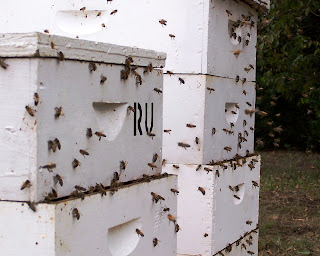A honey bee colony seeks out sources of carbohydrate to make honey anytime that conditions are acceptable for the bees to fly, and bees fly during daylight hours whenever the temperature is above 50 degrees Fahrenheit. Foraging worker bees collect most of their carbohydrate from flower nectar, a thin solution of sugar water. Bees also take unguarded honey from the hive of another bee colony that is too weak to protect its honey stores. This behavior is called “robbing.” For strong colonies, robbing is an efficient method of rapidly gaining additional honey stores, a definite survival strategy. Weak colonies are likely to starve after their honey stores are robbed out. This likely exerts selective pressure to remove weaker colonies or those prone to disease. Two honey bee colonies, even those sitting side-by-side in the same bee yard, do not share stored food resources. Every worker bee is a selfless contributor devoted to the care and protection of its own colony, but not to other colonies. While guard bees protect the hive from all intruders, their main duty involves protecting the colony from robbing by bees from other colonies. For the beekeeper, robbing is not a serious problem as long as there are numerous flowers in bloom. However, during times of dearth, like during the end of summer and early fall, robbing intensifies.
The harvesting of honey by humans has traditionally been called “robbing.” When bees are drawn to the smell of honey, harvesting becomes more difficult. If honey supers or frames of honey are left exposed in an opened hive or outside the hive, they readily induce robbing. The bees’ robbing tendency can be used by the beekeeper, as in today’s photo, to effectively clean honey supers after the harvest. Stack “wet” supers several hundred yards away from the bee yard, and bees will remove any traces of honey in a day’s time. To prevent robbing always reduce hive entrances whenever feeding, making colony divisions, and during the winter.
--Richard










